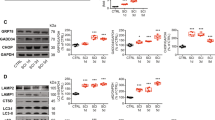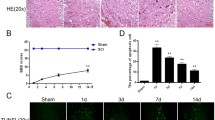Abstract
Spinal cord injury (SCI) is a devastating neurological trauma that causes losses of motor and sensory function. Sestrin2, also known as hypoxia inducible gene 95, is emerging as a critical determinant of cell homeostasis in response to cellular stress. However, the role of sestrin2 in the neuronal response to endoplasmic reticulum (ER) stress and the potential mechanism remain undefined. In this study, we investigated the effects of sestrin2 on ER stress and delineated an underlying molecular mechanism after SCI. Here, we found that elevated sestrin2 is a protective process in neurons against chemical ER stress induced by tunicamycin (TM) or traumatic invasion, while treatment with PERK inhibitor or knockdown of ATF4 reduces sestrin2 expression upon ER stress. In addition, we demonstrated that overexpression of sestrin2 limits ER stress, promoting neuronal survival and improving functional recovery after SCI, which is associated with activation of autophagy and restoration of autophagic flux mediated by sestrin2. Moreover, we also found that sestrin2 activates autophagy dependent on the AMPK-mTOR signaling pathway. Consistently, inhibition of AMPK abrogates the effect of sestrin2 on the activation of autophagy, and blockage of autophagic flux abolishes the effect of sestrin2 on limiting ER stress and neural death. Together, our data reveal that upregulation of sestrin2 is an important resistance mechanism of neurons to ER stress and the potential role of sestrin2 as a therapeutic target for SCI.

Graphical abstract








Similar content being viewed by others
References
Araki K, Nagata K. Protein folding and quality control in the ER. Cold Spring Harb Perspect Biol. 2011;3(11):a007526. https://doi.org/10.1101/cshperspect.a007526.
Badhiwala JH, Wilson JR, Fehlings MG. Global burden of traumatic brain and spinal cord injury. Lancet Neurol. 2019;18(1):24–5. https://doi.org/10.1016/S1474-4422(18)30444-7.
Basso DM, Fisher LC, Anderson AJ, Jakeman LB, McTigue DM, Popovich PG. Basso mouse scale for locomotion detects differences in recovery after spinal cord injury in five common mouse strains. J Neurotrauma. 2006;23(5):635–59. https://doi.org/10.1089/neu.2006.23.635.
Borgese N, Francolini M, Snapp E. Endoplasmic reticulum architecture: structures in flux. Curr Opin Cell Biol. 2006;18(4):358–64. https://doi.org/10.1016/j.ceb.2006.06.008.
Budanov AV, Shoshani T, Faerman A, Zelin E, Kamer I, Kalinski H, et al. Identification of a novel stress-responsive gene Hi95 involved in regulation of cell viability. Oncogene. 2002;21(39):6017–31. https://doi.org/10.1038/sj.onc.1205877.
Cai Y, Arikkath J, Yang L, Guo ML, Periyasamy P, Buch S. Interplay of endoplasmic reticulum stress and autophagy in neurodegenerative disorders. Autophagy. 2016;12(2):225–44. https://doi.org/10.1080/15548627.2015.1121360.
Chen YS, Chen SD, Wu CL, Huang SS, Yang DI. Induction of sestrin2 as an endogenous protective mechanism against amyloid beta-peptide neurotoxicity in primary cortical culture. Exp Neurol. 2014;253:63–71. https://doi.org/10.1016/j.expneurol.2013.12.009.
Civiletto G, Dogan SA, Cerutti R, Fagiolari G, Moggio M, Lamperti C, et al. Rapamycin rescues mitochondrial myopathy via coordinated activation of autophagy and lysosomal biogenesis. EMBO Mol Med. 2018;10(11). https://doi.org/10.15252/emmm.201708799.
Courtine G, Sofroniew MV. Spinal cord repair: advances in biology and technology. Nat Med. 2019;25(6):898–908. https://doi.org/10.1038/s41591-019-0475-6.
Doeppner TR, Kaltwasser B, Bahr M, Hermann DM. Effects of neural progenitor cells on post-stroke neurological impairment-a detailed and comprehensive analysis of behavioral tests. Front Cell Neurosci. 2014;8:338. https://doi.org/10.3389/fncel.2014.00338.
Engel T, Sanz-Rodgriguez A, Jimenez-Mateos EM, Concannon CG, Jimenez-Pacheco A, Moran C, et al. CHOP regulates the p53-MDM2 axis and is required for neuronal survival after seizures. Brain. 2013;136(Pt 2):577–92. https://doi.org/10.1093/brain/aws337.
Han J, Back SH, Hur J, Lin YH, Gildersleeve R, Shan J, et al. ER-stress-induced transcriptional regulation increases protein synthesis leading to cell death. Nat Cell Biol. 2013;15(5):481–90. https://doi.org/10.1038/ncb2738.
Ho A, Cho CS, Namkoong S, Cho US, Lee JH. Biochemical basis of Sestrin physiological activities. Trends Biochem Sci. 2016;41(7):621–32. https://doi.org/10.1016/j.tibs.2016.04.005.
Kim MJ, Bae SH, Ryu JC, Kwon Y, Oh JH, Kwon J, et al. SESN2/sestrin2 suppresses sepsis by inducing mitophagy and inhibiting NLRP3 activation in macrophages. Autophagy. 2016;12(8):1272–91. https://doi.org/10.1080/15548627.2016.1183081.
Lee JH, Budanov AV, Park EJ, Birse R, Kim TE, Perkins GA, et al. Sestrin as a feedback inhibitor of TOR that prevents age-related pathologies. Science. 2010;327(5970):1223–8. https://doi.org/10.1126/science.1182228.
Lee JH, Budanov AV, Karin M. Sestrins orchestrate cellular metabolism to attenuate aging. Cell Metab. 2013;18(6):792–801. https://doi.org/10.1016/j.cmet.2013.08.018.
Li L, Xiao L, Hou Y, He Q, Zhu J, Li Y, et al. Sestrin2 silencing exacerbates cerebral ischemia/reperfusion injury by decreasing mitochondrial biogenesis through the AMPK/PGC-1alpha pathway in rats. Sci Rep. 2016;6:30272. https://doi.org/10.1038/srep30272.
Li H, Liu S, Yuan H, Niu Y, Fu L. Sestrin 2 induces autophagy and attenuates insulin resistance by regulating AMPK signaling in C2C12 myotubes. Exp Cell Res. 2017;354(1):18–24. https://doi.org/10.1016/j.yexcr.2017.03.023.
Li Y, Han W, Wu Y, Zhou K, Zheng Z, Wang H, et al. Stabilization of hypoxia inducible factor-1alpha by Dimethyloxalylglycine promotes recovery from acute spinal cord injury by inhibiting neural apoptosis and enhancing axon regeneration. J Neurotrauma. 2019;36(24):3394–409. https://doi.org/10.1089/neu.2018.6364.
Liu S, Sarkar C, Dinizo M, Faden AI, Koh EY, Lipinski MM, et al. Disrupted autophagy after spinal cord injury is associated with ER stress and neuronal cell death. Cell Death Dis. 2015;6:e1582. https://doi.org/10.1038/cddis.2014.527.
Morris G, Puri BK, Walder K, Berk M, Stubbs B, Maes M, et al. The endoplasmic reticulum stress response in neuroprogressive diseases: emerging pathophysiological role and translational implications. Mol Neurobiol. 2018;55(12):8765–87. https://doi.org/10.1007/s12035-018-1028-6.
Morrison A, Chen L, Wang J, Zhang M, Yang H, Ma Y, et al. Sestrin2 promotes LKB1-mediated AMPK activation in the ischemic heart. FASEB J. 2015;29(2):408–17. https://doi.org/10.1096/fj.14-258814.
Nakka VP, Prakash-Babu P, Vemuganti R. Crosstalk between endoplasmic reticulum stress, oxidative stress, and autophagy: potential therapeutic targets for acute CNS injuries. Mol Neurobiol. 2016;53(1):532–44. https://doi.org/10.1007/s12035-014-9029-6.
Ohtake Y, Sami A, Jiang X, Horiuchi M, Slattery K, Ma L, et al. Promoting axon regeneration in adult CNS by targeting liver kinase B1. Mol Ther. 2019;27(1):102–17. https://doi.org/10.1016/j.ymthe.2018.10.019.
Olson N, Hristova M, Heintz NH, Lounsbury KM, van der Vliet A. Activation of hypoxia-inducible factor-1 protects airway epithelium against oxidant-induced barrier dysfunction. Am J Physiol Lung Cell Mol Physiol. 2011;301(6):L993–L1002. https://doi.org/10.1152/ajplung.00250.2011.
Parikh P, Hao Y, Hosseinkhani M, Patil SB, Huntley GW, Tessier-Lavigne M, et al. Regeneration of axons in injured spinal cord by activation of bone morphogenetic protein/Smad1 signaling pathway in adult neurons. Proc Natl Acad Sci U S A. 2011;108(19):E99–107. https://doi.org/10.1073/pnas.1100426108.
Park HW, Park H, Ro SH, Jang I, Semple IA, Kim DN, et al. Hepatoprotective role of Sestrin2 against chronic ER stress. Nat Commun. 2014;5:4233. https://doi.org/10.1038/ncomms5233.
Pasha M, Eid AH, Eid AA, Gorin Y, Munusamy S. Sestrin2 as a novel biomarker and therapeutic target for various diseases. Oxidative Med Cell Longev. 2017;2017:3296294–10. https://doi.org/10.1155/2017/3296294.
Quan N, Sun W, Wang L, Chen X, Bogan JS, Zhou X, et al. Sestrin2 prevents age-related intolerance to ischemia and reperfusion injury by modulating substrate metabolism. FASEB J. 2017;31(9):4153–67. https://doi.org/10.1096/fj.201700063R.
Salvany S, Casanovas A, Tarabal O, Piedrafita L, Hernandez S, Santafe M, et al. Localization and dynamic changes of neuregulin-1 at C-type synaptic boutons in association with motor neuron injury and repair. FASEB J. 2019;33(7):7833–51. https://doi.org/10.1096/fj.201802329R.
Sarkar C, Zhao Z, Aungst S, Sabirzhanov B, Faden AI, Lipinski MM. Impaired autophagy flux is associated with neuronal cell death after traumatic brain injury. Autophagy. 2014;10(12):2208–22. https://doi.org/10.4161/15548627.2014.981787.
Shi X, Doycheva DM, Xu L, Tang J, Yan M, Zhang JH. Sestrin2 induced by hypoxia inducible factor1 alpha protects the blood-brain barrier via inhibiting VEGF after severe hypoxic-ischemic injury in neonatal rats. Neurobiol Dis. 2016;95:111–21. https://doi.org/10.1016/j.nbd.2016.07.016.
Shin BY, Jin SH, Cho IJ, Ki SH. Nrf2-ARE pathway regulates induction of Sestrin-2 expression. Free Radic Biol Med. 2012;53(4):834–41. https://doi.org/10.1016/j.freeradbiomed.2012.06.026.
Silva NA, Sousa N, Reis RL, Salgado AJ. From basics to clinical: a comprehensive review on spinal cord injury. Prog Neurobiol. 2014;114:25–57. https://doi.org/10.1016/j.pneurobio.2013.11.002.
Tator CH, Fehlings MG. Review of the secondary injury theory of acute spinal cord trauma with emphasis on vascular mechanisms. J Neurosurg. 1991;75(1):15–26. https://doi.org/10.3171/jns.1991.75.1.0015.
Valenzuela V, Collyer E, Armentano D, Parsons GB, Court FA, Hetz C. Activation of the unfolded protein response enhances motor recovery after spinal cord injury. Cell Death Dis. 2012;3:e272. https://doi.org/10.1038/cddis.2012.8.
Wan H, Wang Q, Chen X, Zeng Q, Shao Y, Fang H, et al. WDR45 contributes to neurodegeneration through regulation of ER homeostasis and neuronal death. Autophagy. 2019;16:1–17. https://doi.org/10.1080/15548627.2019.1630224.
Wang Q, Zhang H, Xu H, Zhao Y, Li Z, Li J, et al. Novel multi-drug delivery hydrogel using scar-homing liposomes improves spinal cord injury repair. Theranostics. 2018a;8(16):4429–46. https://doi.org/10.7150/thno.26717.
Wang Y, Wu W, Wu X, Sun Y, Zhang YP, Deng LX, et al. Remodeling of lumbar motor circuitry remote to a thoracic spinal cord injury promotes locomotor recovery. eLife. 2018b;7. https://doi.org/10.7554/eLife.39016.
Wang P, Zhao Y, Li Y, Wu J, Yu S, Zhu J, et al. Sestrin2 overexpression attenuates focal cerebral ischemic injury in rat by increasing Nrf2/HO-1 pathway-mediated angiogenesis. Neuroscience. 2019;410:140–9. https://doi.org/10.1016/j.neuroscience.2019.05.005.
Ye J, Palm W, Peng M, King B, Lindsten T, Li MO, et al. GCN2 sustains mTORC1 suppression upon amino acid deprivation by inducing Sestrin2. Genes Dev. 2015;29(22):2331–6. https://doi.org/10.1101/gad.269324.115.
Yin Y, Sun G, Li E, Kiselyov K, Sun D. ER stress and impaired autophagy flux in neuronal degeneration and brain injury. Ageing Res Rev. 2017;34:3–14. https://doi.org/10.1016/j.arr.2016.08.008.
Yu PB, Hong CC, Sachidanandan C, Babitt JL, Deng DY, Hoyng SA, et al. Dorsomorphin inhibits BMP signals required for embryogenesis and iron metabolism. Nat Chem Biol. 2008;4(1):33–41. https://doi.org/10.1038/nchembio.2007.54.
Zhang D, Xuan J, Zheng BB, Zhou YL, Lin Y, Wu YS, et al. Metformin improves functional recovery after spinal cord injury via autophagy flux stimulation. Mol Neurobiol. 2017;54(5):3327–41. https://doi.org/10.1007/s12035-016-9895-1.
Zhao YZ, Jiang X, Xiao J, Lin Q, Yu WZ, Tian FR, et al. Using NGF heparin-poloxamer thermosensitive hydrogels to enhance the nerve regeneration for spinal cord injury. Acta Biomater. 2016;29:71–80. https://doi.org/10.1016/j.actbio.2015.10.014.
Zheng Z, Zhou Y, Ye L, Lu Q, Zhang K, Zhang J, et al. Histone deacetylase 6 inhibition restores autophagic flux to promote functional recovery after spinal cord injury. Exp Neurol. 2019;324:113138. https://doi.org/10.1016/j.expneurol.2019.113138.
Funding
This work was supported by grants from Natural Science Foundation of China (81722028, 81972150), Zhejiang Public Service Technology Research Program and Social Development (LGF18H060008), Natural Science Foundation of Zhejiang.
Province (LR18H50001, LQ18H090008), CAMS Innovation Fund for Medical Sciences (2019-I2M-5-028).
Author information
Authors and Affiliations
Contributions
Yao Li designed the research and wrote the paper; Jing Zhang and Kailiang Zhou assisted in performing the in vivo and in vitro experiments; Ling Xie, Guangheng Xiang, and Mingqiao Fang guided the experiments and image acquisition; Wen Han modified the syntax of the paper; Xiangyang Wang and Xiao Jian assisted in designing the research and approved the final version to be submitted.
Corresponding authors
Ethics declarations
Conflict of interest
The authors declare no conflicts of interest.
Additional information
Publisher’s note
Springer Nature remains neutral with regard to jurisdictional claims in published maps and institutional affiliations.
Electronic supplementary material
ESM 1
(DOCX 2506 kb)
Rights and permissions
About this article
Cite this article
Li, Y., Zhang, J., Zhou, K. et al. Elevating sestrin2 attenuates endoplasmic reticulum stress and improves functional recovery through autophagy activation after spinal cord injury. Cell Biol Toxicol 37, 401–419 (2021). https://doi.org/10.1007/s10565-020-09550-4
Received:
Accepted:
Published:
Issue Date:
DOI: https://doi.org/10.1007/s10565-020-09550-4




